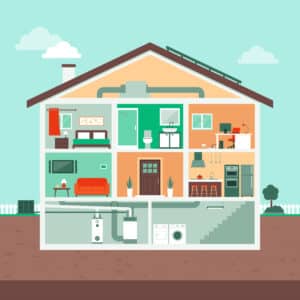Unlock Comfort: Understand How HVAC Zoning Works
Save Energy and Improve Performance

Heating, ventilation, and air conditioning zoning is an effective, cost saving approach to climate control that allows you to customize temperatures in different areas of your home. By dividing the house into multiple zones with individual temperature controls, HVAC zoning maximizes comfort, energy efficiency, and most of all, savings. How does it work, you ask? You’ve come to the right place. We’ve got answers, below:
Zone Dampers
At the heart of HVAC zoning are zone dampers, which are installed within the ductwork to regulate airflow to specific areas or zones of the home. Zone dampers open or close based on signals from the thermostat, directing conditioned air to appropriate zones while restricting airflow to others. This allows you to adjust temperatures independently in one space over another, optimizing comfort while avoiding heating or cooling rooms you’re not using.
Thermostat Control
Each zone in an HVAC zoning system is equipped with its own thermostat, letting occupants set and maintain individual temperatures according to their preferences. Thermostats communicate with the HVAC system and zone dampers to regulate heating and cooling output based on the desired temperature settings in each zone. Grandma can keep it toasty, while your children can keep it cool. This means everyone can enjoy personalized comfort throughout your home.
Zoning Panels and Controls
Zoning panels serve as mission control for the HVAC zoning system, coordinating communication between thermostats, zone dampers, and all other heating and cooling equipment. These panels receive signals from individual thermostats that determine which dampers to open or close, depending on the desired temperatures in each zone. Some panels feature programmable settings, occupancy sensors, and even remote access capabilities for added convenience and efficiency.
Flexibility and Customization
One of the primary benefits of HVAC zoning are the customization options this kind of system offers. Homeowners can divide their home into multiple heating and cooling areas based on factors like floor plan layout, occupancy patterns, and temperature preferences. Common zoning configurations include separate zones for bedrooms, living areas, and basement or attic spaces, allowing everyone in your family to set comfort levels to their specific needs.
Energy Efficiency and Cost Savings
HVAC zoning offers significant energy efficiency benefits by reducing heating and cooling loads in unoccupied or rarely used areas of your home. By directing conditioned air only to places that need it, HVAC zoning minimizes waste and reduces your energy costs. Zoning also lets you implement even lower temperatures in unoccupied zones, further optimizing your energy usage and keeping utility bills low.
Enhanced Comfort and Air Quality
With HVAC zoning, you can expect consistent indoor comfort levels throughout your home, eliminating temperature imbalances and hot or cold spots. With precise temperature control in each designated area, HVAC zoning also promotes better indoor air quality by minimizing humidity fluctuations and preventing over-conditioning or under-conditioning of your indoor air.
A zoned HVAC system is a no-brainer for personalized comfort control and energy savings. Don’t zone out: give us a call today to discuss how you can implement this sensible strategy for your heating and air conditioning.
Since 1969, Air-Tro has been the family owned heating and air conditioning company trusted by the San Gabriel Valley for all their HVAC needs. Call us today at (626)357-3535.
